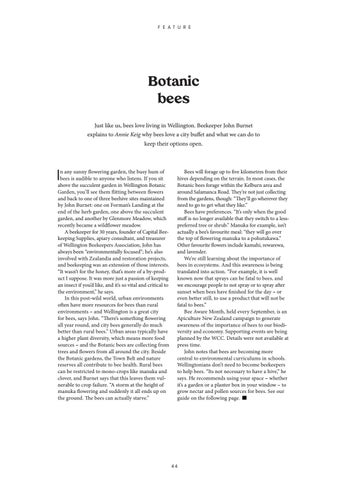F E AT U R E
Botanic bees Just like us, bees love living in Wellington. Beekeeper John Burnet explains to Annie Keig why bees love a city buffet and what we can do to keep their options open.
I
n any sunny flowering garden, the busy hum of bees is audible to anyone who listens. If you sit above the succulent garden in Wellington Botanic Garden, you’ll see them flitting between flowers and back to one of three beehive sites maintained by John Burnet: one on Forman’s Landing at the end of the herb garden, one above the succulent garden, and another by Glenmore Meadow, which recently became a wildflower meadow. A beekeeper for 30 years, founder of Capital Beekeeping Supplies, apiary consultant, and treasurer of Wellington Beekeepers Association, John has always been “environmentally focused”; he’s also involved with Zealandia and restoration projects, and beekeeping was an extension of those interests. “It wasn’t for the honey, that’s more of a by-product I suppose. It was more just a passion of keeping an insect if you’d like, and it’s so vital and critical to the environment,” he says. In this post-wild world, urban environments often have more resources for bees than rural environments – and Wellington is a great city for bees, says John. “There’s something flowering all year round, and city bees generally do much better than rural bees.” Urban areas typically have a higher plant diversity, which means more food sources – and the Botanic bees are collecting from trees and flowers from all around the city. Beside the Botanic gardens, the Town Belt and nature reserves all contribute to bee health. Rural bees can be restricted to mono-crops like manuka and clover, and Burnet says that this leaves them vulnerable to crop failure. “A storm at the height of manuka flowering and suddenly it all ends up on the ground. The bees can actually starve.”
Bees will forage up to five kilometres from their hives depending on the terrain. In most cases, the Botanic bees forage within the Kelburn area and around Salamanca Road. They’re not just collecting from the gardens, though: “They’ll go wherever they need to go to get what they like.” Bees have preferences. “It’s only when the good stuff is no longer available that they switch to a lesspreferred tree or shrub.” Manuka for example, isn’t actually a bee’s favourite meal: “they will go over the top of flowering manuka to a pohutukawa.” Other favourite flowers include kamahi, rewarewa, and lavender. We’re still learning about the importance of bees in ecosystems. And this awareness is being translated into action. “For example, it is well known now that sprays can be fatal to bees, and we encourage people to not spray or to spray after sunset when bees have finished for the day – or even better still, to use a product that will not be fatal to bees.” Bee Aware Month, held every September, is an Apiculture New Zealand campaign to generate awareness of the importance of bees to our biodiversity and economy. Supporting events are being planned by the WCC. Details were not available at press time. John notes that bees are becoming more central to environmental curriculums in schools. Wellingtonians don’t need to become beekeepers to help bees. “Its not necessary to have a hive,” he says. He recommends using your space – whether it’s a garden or a planter box in your window – to grow nectar and pollen sources for bees. See our guide on the following page.
44
